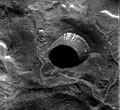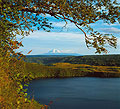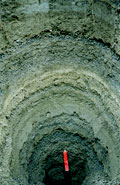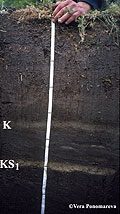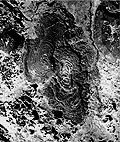A
number of fresh-looking isolated volcanic vents are located at the
far eastern flanks of the Sredinny Range in the Elovka River basin.
Three of them appeared to be as young as the Holocene (Pevzner,
2006): Kinenin maar (57°21’N,
160°58’E; wall elev. 583.4 m;
GVP number 1000-551); Bliznetsy twin
lava flows (57°21’N, 161°22’E;
elev. of the highest point 265.0
m; GVP
number 1000-552) and Shisheika lava
dome (57° 09’ N, 161°05’E; elev. 378.5 m;
GVP number 1000-511).
Kinenin maar (Figs.
1 and 2) was named by Maria Pevzner (2006) by the Kinenin River (a
tributary of the Elovka River). The maar is filled with a lake ~1
km across. Based on tephrochronological data and radiocarbon dates, Kinenin maar
was formed by a phreato-magmatic eruption ~1.1 ka BP (Pevzner,
2006). The crater wall is composed mostly of desintegrated host
rocks with
some admixture of fresh mafic bombs at the top of the sequence.
The tephra of this eruption was spread to ENE and can be traced
as far
as the Pacific coast, >100 km from the source (Figs. 3 and 4).
The volume of the erupted material is estimated at ~0.5 km3.
Juvenile
mafic bombs from Kinenin maar are characterized by
high Mg (Mg#0.65-0.67), Cr, Co, Ni, V, and Ba content (Babansky
et al., 2006). These features make Kinenin basalts
similar to the mafic tephra erupted from Shiveluch volcano ~7600 14С yrs
BP (Volynets et al., 1997). Kinenin basalts, however,
have higher HFSE concentrations compared to the Shiveluch tephra
that may have resulted from the participation of the HFSE-enriched
source in Kinenin magma genesis.
Bliznetsy ("twins" in
Russian) are two adjacent lava flows erupted
from closely spaced vents, which are located 25
km to the east of the Kinenin maar and 80
km north of Shiveluch volcano (Figs. 5 and 6). Area
of the two lava flows is 5 km2 (length 2.5 km, width
2 km). Volume of the erupted medium-K
andesite is
estimated at 0.15 km3. Based on tephrochronological
and radiocarbon data, the eruption took place ~3 ka BP (Pevzner,
2006).
Shisheika lava
dome (Fig. 7) is
located at the right bank of Shishei River, 60 km NNW of Shiveluch volcano.
Area of the lava body is 4 km2; average thickness is
~150 m. Volume of erupted medium-K
andesite-dacite is
estimated at 0.5-0.6 km3. The erupion took place ~4.2
ka BP as suggested by the stratigraphic position of its tephra
and a radiocarbon date obtained below the latter. The eruption
produced also a minor tephra fall.
The
described three volcanic centers erupted basalts, basaltic andesites,
andesites and dacites. All the rocks have similar geochemical features:
they belong to medium-K calc-alkaline series and have an arc-type
trace elements patterns (Nb minimum, high K, Cs, Rb, Ba, Sr concentrations).
Literature
Babansky
A.D., Pevzner M.M., Volynets A.O. (2006)
Petrology, geochemistry and geodynamics of Holocene volcanism in
the Elovka River basin (North Kamchatka). Volcanism and geodynamics.
Abstracts of the 3rd All-Rissia symposium on volcanology and paleovolcanology,
Ulan-Ude, September 5-8, 2006, pp.512-515.
Pevzner
M.M. (2006) Holocene volcanism of Northern Kamchatka: The spatiotemporal
aspect. Doklady of the Russian Academy of Sciences, Earth Sciences,
Vol. 409A, No. 6, pp. 884–887. Original Russian text published in Doklady
Akademii Nauk, 2006, Vol. 409, No. 5, pp. 648–651.
Siebert
L, and Simkin T (2002-). Volcanoes
of the World: an Illustrated Catalog of Holocene Volcanoes and their
Eruptions. Smithsonian Institution, Global Volcanism Program, Digital
Information Series, GVP-3, (http://www.volcano.si.edu/world/).
